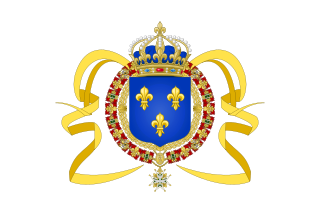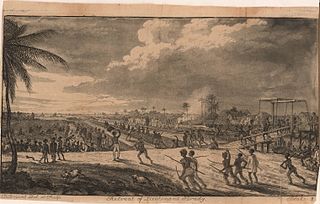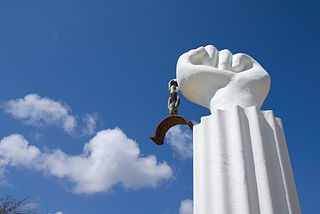National hero

The anniversary of the Cuffy slave rebellion, 23 February, has been Republic Day in Guyana since 1970. Cuffy is commemorated in the 1763 Monument in the Square of the Revolution in the capital Georgetown. [1]
Cuffy, also spelled Coffy, Kofi or Koffi (died in 1763), was an Akan man who was captured in his native West Africa and stolen for slavery to work in the plantations of the Dutch colony of Berbice in present-day Guyana. He became famous because in 1763 he led a revolt of more than 2,500 slaves against the colony regime. Today, he is a national hero in Guyana. [1]
Cuffy lived in Lilienberg, a plantation on the Canje River, as a house-slave for a cooper (barrel maker). An uprising broke out at Magdalenenberg plantation, upper Canje River, in February 1763 and moved on to neighbouring plantations, attacking owners. When Dutch Governor Wolfert Simon Van Hoogenheim sent military assistance to the region, the rebellion had reached the Berbice River and was moving steadily towards the Berbice capital, Fort Nassau. They took gunpowder and guns from the attacked plantations.
By 3 March the rebels were 500 in number. Led by Cosala,[ citation needed ] they tried to take the brick house of Peerenboom. They agreed to allow the whites to leave the brick house, but as soon they left, the rebels killed many and took several prisoners, among them the daughter of the Peerenboom Plantation owner, whom Cuffy kept as his wife. [2]
Cuffy was soon accepted by the rebels as their leader and declared himself Governor of Berbice. Doing so he named Akara as his deputy and tried to establish discipline over the troops. Akara was skilful in military discipline. They organized the farms in order to provide food supplies.
Wolfert Simon Van Hoogenheim committed himself to retake the colony. Akara attacked the whites three times without permission from Cuffy, but they were driven back. Thus began a dispute among the two rebels. On 2 April 1763 Cuffy wrote to Van Hoogenheim saying that he did not want a war against the whites and proposed a partition of Berbice with the whites occupying the coastal areas and the blacks the interior. [3] Van Hoogenheim delayed his decision waiting for support from neighboring colonies. Cuffy then ordered his forces to attack the whites on 13 May 1763, but in so doing had many losses. The defeat opened a division among the rebels and weakened their organization. Akara became the leader of a new faction opposed to Cuffy and led to a civil war among themselves. When Akara won, Cuffy was captured and killed by the Dutch.

The anniversary of the Cuffy slave rebellion, 23 February, has been Republic Day in Guyana since 1970. Cuffy is commemorated in the 1763 Monument in the Square of the Revolution in the capital Georgetown. [1]

A slave rebellion is an armed uprising by slaves. Slave rebellions have occurred in nearly all societies that practice slavery or have practiced slavery in the past. A desire for freedom and the dream of successful rebellion are often the greatest objects of song, art, and culture amongst the enslaved population. Many of the events, however, are often violently opposed and suppressed by slaveholders.
The recorded history of Guyana can be dated back to 1499, when Alonso de Ojeda's first expedition arrived from Spain at the Essequibo River. The history of Guyana has been shaped by the participation of many national and ethnic groups, as well as the colonial policies of the Spanish, French, Dutch, and British. The African slave rebellions in 1763 and 1823 were seminal moments in the nation's history. Africans were enslaved and transported to Guyana as slaves; in contrast, East Indians came as indentured labourers. Guyana's recent history is characterized in particular by the struggle to free itself from colonial rule, and from the lingering effects of colonialism.

British Guiana was a former British colony, part of the British West Indies, which resided on the northern coast of South America, now known as the independent nation of Guyana.

Saint-Domingue was a French colony on the Caribbean island of Hispaniola from 1659 to 1804, in what is now Haiti.

The Stono Rebellion was a slave rebellion that began on 9 September 1739, in the colony of South Carolina. It was the largest slave uprising in the British mainland colonies, with 25 colonists and 35 to 50 Africans killed. The uprising was led by native Africans who were likely from the Central African Kingdom of Kongo, as some of the rebels spoke Portuguese.

Demerara is a historical region in the Guianas on the north coast of South America which is now part of the country of Guyana. It was a Dutch colony until 1815 and a county of British Guiana from 1838 to 1966. It was located about the lower courses of the Demerara River, and its main town was Georgetown.

New Amsterdam is one of the largest towns in Guyana, located in the East Berbice-Corentyne Region, 100 kilometres (62 mi) from the capital, Georgetown. It is located on the eastern bank of the Berbice River, 6 km (4 mi) upriver from its mouth at the Atlantic Ocean, and immediately south of the Canje River. New Amsterdam's population is approximately 33,000.
Cuffy may refer to:

Berbice is a region along the Berbice River in Guyana, which was between 1627 and 1815 a colony of the Netherlands. After having been ceded to the United Kingdom in the latter year, it was merged with Essequibo and Demerara to form the colony of British Guiana in 1831. In 1966, British Guiana gained independence as Guyana.
Afro-Guyanese people are generally descended from slaves brought to the Guianas from the coast of West Africa to work on sugar plantations

The Canje River, located in northeastern Guyana, is the main tributary of the Berbice River. It runs roughly parallel to the Atlantic Ocean coast.
The Berbice slave uprising was a slave revolt in Guyana that began on 23 February 1763 and lasted to December. It is seen as a major event in Guyana's anti-colonial struggles, and when Guyana became a republic in 1970 the state declared 23 February as a day to commemorate the start of the Berbice slave revolt.

The 1733 slave insurrection on St. John in the Danish West Indies started on November 23, 1733, when 150 African slaves from Akwamu revolted against the owners and managers of the island's plantations. Lasting several months into August 1734, the slave rebellion was one of the earliest and longest slave revolts in the Americas. The Akwamu slaves captured the fort in Coral Bay and took control of most of the island. They intended to resume crop production under their own control and use Africans of other tribes as slave labor.

The Demerara rebellion of 1823 was an uprising involving more than 10,000 slaves that took place in the colony of Demerara-Essequibo (Guyana). The rebellion, which took place on 18 August 1823 and lasted for two days, was led by slaves with the highest status. In part they were reacting to poor treatment and a desire for freedom; in addition, there was a widespread, mistaken belief that Parliament had passed a law for emancipation, but it was being withheld by the colonial rulers. Instigated chiefly by Jack Gladstone, a slave at "Success" plantation, the rebellion also involved his father, Quamina, and other senior members of their church group. Its English pastor, John Smith, was implicated.

Quamina Gladstone, most often referred to simply as Quamina, was a Guianese slave, a Coromantee, who was father of Jack Gladstone. He and his son were involved in the Demerara rebellion of 1823, one of the largest slave revolts in the British colonies before slavery was abolished.
Coromantee, Coromantins, Coromanti or Kormantine was the English name for enslaved people from the Akan ethnicity from the Gold Coast in modern Ghana. The term was primarily used in the Caribbean and is now considered archaic.

Fort Nassau was the capital of the Dutch colony of Berbice, in present-day Guyana. It was situated on the Berbice River approximately 88 kilometres upstream from New Amsterdam.
The Society of Berbice was founded on 24 October 1720 by the owners of the colony of Berbice. These owners, brothers Nicolaas and Hendrik van Hoorn, Arnold Dix, Pieter Schuurmans, and Cornelis van Peere, had acquired the colony from the French on 24 October 1714, who in turn had occupied the colony which was previously a hereditary fief in the possession of the Van Peere family.

Surinam was a Dutch plantation colony in the Guianas, neighboured by the equally Dutch colony of Berbice to the west, and the French colony of Cayenne to the east. Surinam was a Dutch colony from 26 February 1667, when Dutch forces captured Francis Willoughby's English colony during the Second Anglo-Dutch War, until 15 December 1954, when Surinam became a constituent country of the Kingdom of the Netherlands. The status quo of Dutch sovereignty over Surinam, and English sovereignty over New Netherland, which it had conquered in 1664, was kept in the Treaty of Breda of 31 July 1667, and again confirmed in the Treaty of Westminster of 1674.

A slave revolt took place in the Dutch colony of Curaçao in 1795, led by Tula, a local slave, and resulted in a month-long conflict on the island between escapees and the colonial government.
| This Guyanese biographical article is a stub. You can help Wikipedia by expanding it. |
| This biographical article related to the South American military is a stub. You can help Wikipedia by expanding it. |